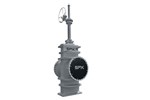SPX FLOW offers a range of flow control solutions that are suited to liquid terminals and tank storage applications. Renowned for their high reliability, low maintenance and long service life, SPX FLOW mixers and valves contribute to the efficient, economical, and safe distribution of liquid commodities throughout the world.
Storage of crude oil results in the settlement of Bottom Sludge and Water (BS&W), which needs to be removed regularly to prevent accumulations that can cause corrosion or seriously reduce operational efficiency. Plenty TMH Side Entry Mixers prevent harmful sludge from settling by ensuring that heavy solids, water and corrosive salts are maintained in suspension. TMH mixers are equipped with a toothed belt and high efficiency impellers for optimum mixing and energy efficiency. Downtime is reduced through a tank shut-off device to allow the shaft seal and bearings to be changed under full tank conditions, while the maintenance-free bearings have a L10 life in excess of 65,000 hours.
For precise fluid control, SPX FLOW offers the M&J Valve Model M-303 slab gate valve, which is manufactured and tested to API-6D. The floating slab gate uses the natural force of line pressure to obtain a dynamically tight downstream seal in high-pressure differential applications. Low-pressure sealing is accomplished with coil springs that energize the seat, pushing it against the gate. Ease of maintenance and versatility make the M-303 a leading gate valve in the industry. Another option is the Compact Expanding Gate (CEG) Valve, a full opening, non-thru-conduit, mechanically sealing valve that achieves superior sealing by utilization of a two-piece parallel expanding gate. The mechanical sealing performance makes it ideal for critical double block and bleed applications.
Where line pressure surges are an issue, SPX FLOW offers the DANFLO 400 Series. Essentially, these valves consist of a dynamically balanced plug assembly to rapidly open, close, and throttle the valve. Surge-relief control is achieved by “loading” the plug cavity from a regulated nitrogen source. A line pressure surge above the nitrogen “set” pressure opens the valve immediately to relieve the extra surge volume. The plug “tracks” line pressure until equilibrium is re-established and the valve closes.


